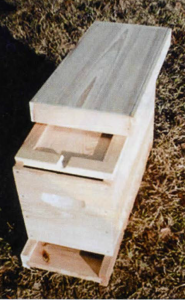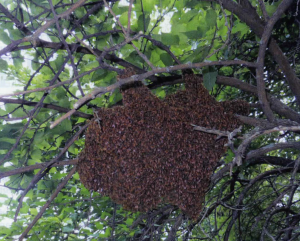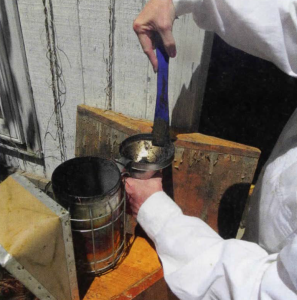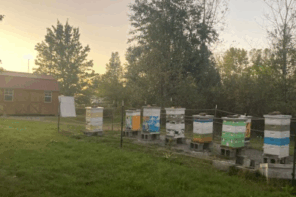By: Ann Harman
This article originally appeared in the Winter 2019 issue of BEEKeeping Your First Three Years
The honey bee is much more attuned to the world around her than you are. After all, during good weather she is flying about in thousands of acres. You know the area around your home and where you travel during the course of a day or a week. If you are walking you probably notice much more about the general surroundings than if you are traveling in a car. Bees of foraging age, especially the scout bees, are outside exploring every day except when too cold or raining. The bees’ existence depends on sources of food, the pollen and nectar, and also water.
The flowering plants, the bee’s source of food, respond to the weather and the changing seasons. We also respond but in a different way. Do I need a raincoat today? In cold climates you want a warm jacket as Autumn approaches. You know when your vegetable garden needs water and when the tomatoes are ready for picking. As a beekeeper now you need to broaden your world to include that of your bees’. They do not know it but you are their provider of a home, a water source and food if they need it. Therefore we need to understand how to be that provider throughout the year.
 Our choice of their home depends both on their needs and our capabilities. Manufacturers, large and small, of beekeeping equipment offer a wide selection of hives. You can, of course, create your own. However if you do that you must always remember Langstroth’s discovery of bee space. That must be honored everywhere inside any hive. If you ignore it, or overlook it, the bees are happy to correct your mistakes. Their corrections can make a hive completely unusable as far as the beekeeper is concerned.
Our choice of their home depends both on their needs and our capabilities. Manufacturers, large and small, of beekeeping equipment offer a wide selection of hives. You can, of course, create your own. However if you do that you must always remember Langstroth’s discovery of bee space. That must be honored everywhere inside any hive. If you ignore it, or overlook it, the bees are happy to correct your mistakes. Their corrections can make a hive completely unusable as far as the beekeeper is concerned.
If you are unhappy with your first choice of hive it is possible to move the bees into one entirely different. The best time of year to do that is when your weather breaks into Spring. Then the bee population is increasing. The food sources are plentiful. The colony will have plenty of bees of comb-building age to reconstruct brood comb. It will be warm enough so that they do not need to form tight clusters if nights are chilly.
If you decide you do not wish to change, then January is a good time to review your equipment, both in the beeyard and any that you may have stored for the Winter. For those who are planning for their first honey harvest this coming season, now is a good time to decide what equipment will be necessary for that – make a list. Consult with others in your local bee club for suggestions. (Do you belong to a local club? If not, it is a very good idea.) Get help and suggestions from your mentor.
If one or more of your colonies died during the Winter months, and is disease-free, you can install a package or a nuc or a swarm into that hive. However, inspect the comb to see if any needs replacement. Damaged or badly-made comb may not be repaired.
While you are considering hives, keep in mind that equipment suppliers have sales in January. Take advantage of those. Also keep in mind that when bee season gets into full swing, these suppliers are incredibly busy with orders. Procrastinating beekeepers are in a panic. The equipment suppliers are coping with everyone wanting their order filled and shipped now! Stock of equipment runs out. Filling orders and shipping takes more time than usual. Make January your shopping month, especially if your nectar flow is early. If you are placing an order for equipment, don’t forget containers for your honey crop. Even if your crop fails this year, containers keep.
Local clubs frequently have the large equipment for extracting honey that can be rented for a few days. (Another good reason to join a local club.) Uncapping knife and extractor are the two usual pieces available. However you will need some food-grade buckets, one with a gate for bottling, plus a set of strainers. So you might think about adding these to an equipment order. If you extracted honey last year, think back about what you needed or wished you had.
Did you check and clean up your smoker before you put it away at the end of the season? If not, now is the time to do it. Check the bellows for damage or leaks. And by the way, how is your supply of smoker fuel? You need to have plenty at the start of bee season.
Review your own bee clothing. Do you find any holes that need mending before the bees find them? Check your veil carefully all around. You really do not want that one little bee finding a hole and crawling inside. Perhaps you wish to try another style of veil. These items can be ordered along with equipment.
One piece of equipment needed is some type of feeder for sugar syrup. The equipment suppliers have several basic styles. You can choose which style you like and can certainly try different ones. However it is very important to realize that sugar syrup can ferment if it is in 1:1 dilution (one part sugar to one part water). Not only that, but with any dilution, mold can be a problem. It is essential that all feeders, no matter the style, must be washed thoroughly. Scrubbing all parts with a brush will help. Giving all parts a rinse with bleach in water followed by a good rinsing is highly recommended. Just because it looks clean, wash it between fillings. While you are cleaning a feeder check for any damage or leaks. Never put it away in storage without that good scrubbing and washing first.
If you are a first-time beekeeper and taking beekeeping classes during these months you will be selecting equipment you will need to have ready when your bees arrive. If you are buying local nucs you need to keep up to date on when these will be available. Even packages of bees have somewhat flexible shipping dates. Plan where your beeyard will be and have the hives ready and in place before those dates.
If you had had bees for one or two years, go back and review your records. (You are keeping records?) This is a good time to see if you made any comments about equipment needs or something that just did not work.
It is difficult to predict whether this year (or any year) is going to be a good one for bees and for a honey crop. You need to be both a Plant Watcher and a Weather Watcher. In many areas of the country an unexpected storm can put an end to fragile blossoms. However, you need to be monitoring the weather and plants all the time – just like your bees.
The problems bees are having has greatly increased the interest in bee-friendly plants, not only those in our gardens but also those in agricultural crop areas, along roads and highways and solar farms. Local beekeeping clubs, as well as state associations have provided their members with lists or booklets of suitable plants. Large books on bee plants have been published. Bee plant books are an essential part of a beekeeper’s library. You need to learn where the early pollen and nectar plants are in your area. Those, combined with suitable foraging weather mean your bees are busy collecting their own food and may not need to be fed.
Now that you have some information on your local bee plants, it is time to walk, or go by bicycle, horse or car to find the bee plants in your bees’ area. If you are uncertain of the identification, field guides to trees and wildflowers are inexpensive and very handy. Now you can find the trees and other plants that will provide a honey crop. You can keep track of the pollen and nectar plants from late Winter until late Autumn.
Combine your plant watching with the weather. Are the bees able to leave the hive to collect pollen and nectar? Prolonged bad weather or a serious drought should tell you that it’s time to check your bees’ food supply. Beekeepers can be fooled into thinking that because it’s Summer the bees must have plenty of food. Some states have planted the roadsides and median strips with bee-friendly flowers. You can find out by simply observing or can call the state Department of Transportation. Other states have not followed this planting. Perhaps encouragement from beekeepers is needed for those states.
Do you live in an area with small hive beetles? Just because you have not seen them does not mean they are not there. Spring, as the weather warms, is the time for beetles to resume egg-laying. The beetle is small and very quick to hide under bees when you pull a frame for inspection. If you have been attending your local club meetings you would know if they are in your area. If they are not, you still need to be aware that they could arrive. The adults are strong fliers and can fly quite a distance. Keep up to date on control methods.
One piece of equipment is sometimes overlooked. A covered container for those lumps of wax you are scraping off from the inside of the hive. Leaving hive scrapings and spilling sugar syrup attracts all kinds of critters, large and small, to your beeyard. Do not discard pieces of equipment in the beeyard. It may smell of bees (not necessarily to you) and attract critters also.
Spring brings swarm season. No matter how attentive beekeepers are for inspecting for queen cells, many times a capped cell is overlooked. If the honey crop plants bloom early in bee season, the honey crop may be lost. Swarm catching can expand your number of hives. It would be a good idea to plan in advance of swarm season. What will you use to capture a swarm? Do you have empty equipment to hive the swarm? Those bees in the swarm are ready to build comb so they need a hive immediately. If you use Langstroth-type hives you can install the swarm into a honey super while waiting for replacement equipment to arrive from a supplier.

No matter how attentive beekeepers are for inspecting for queen cells, many times a capped cell is overlooked.
How did your Varroa plan work last season? If you came through the Winter with all colonies alive and thriving then you did very well. If you lost colonies you are not alone. How did you check for Varroa – with powdered sugar or with an alcohol wash? The present thinking is that the powdered sugar shake is not as good as an alcohol wash. If you are ordering equipment, put the Varroa Easy Check on your list. The instructions are easy to follow and it is easy to use. Although you may kill 300 bees, a well-populated colony will not suffer because it’s a small loss. After all, one hundred or more bees die each day of “old age.” In Spring they are being replaced rapidly.
As Spring arrives you are entering your new bee season. Whether your Winter is leaving or lingering, think about your new bee season. Are you ready for it?










